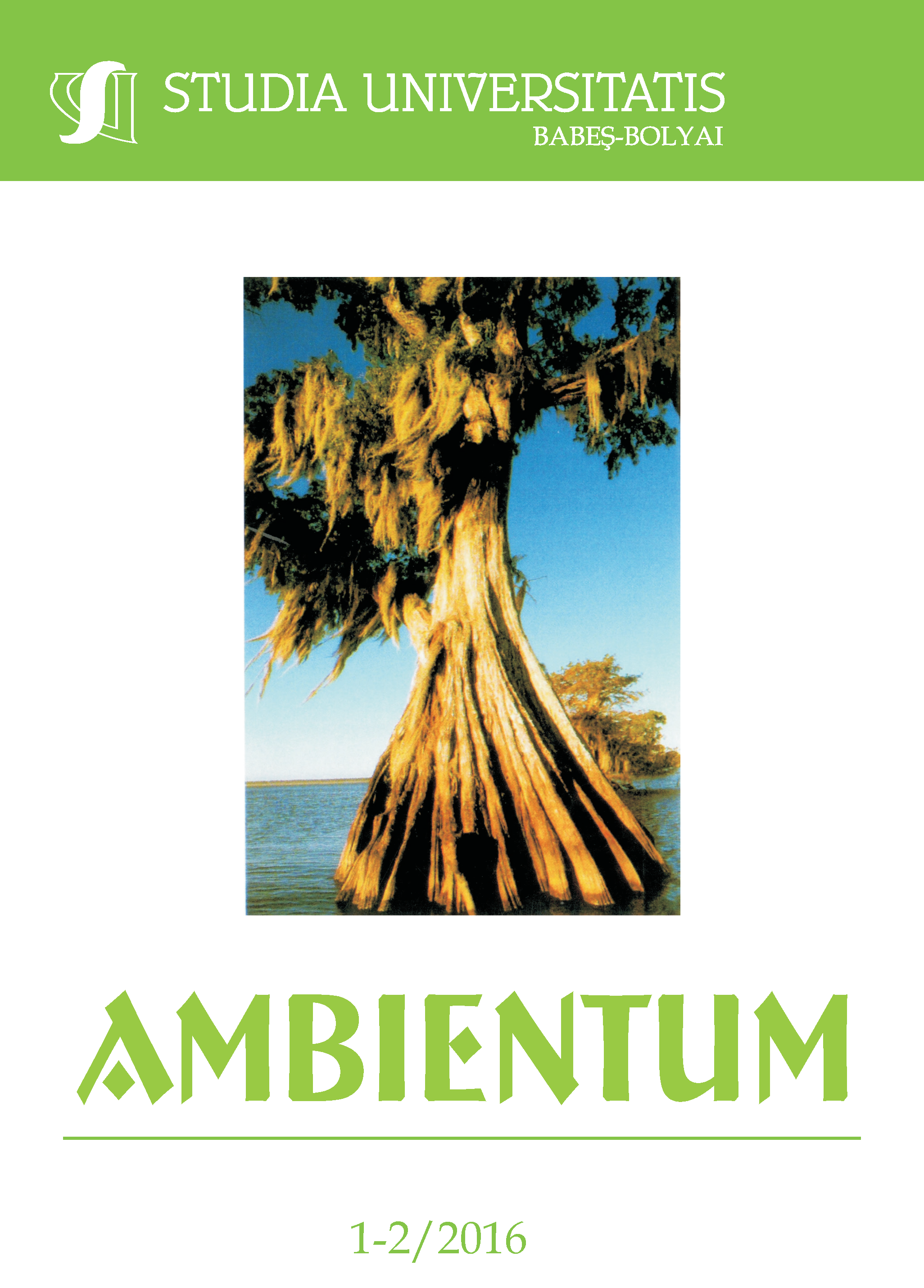ASSESSMENT OF THE TRANSFER PHENOMENA FOR HEAVY METALS IN A FRESHWATER ECOSYSTEM: A FIELD STUDY
Keywords:
heavy metals, Plumbuita Lake, bioaccumulationAbstract
Increasingly higher concentrations of heavy metals in aquatic environments pose a major risk to living organisms, as a result of their bioaccumulation and toxicity. For the assessment of the bioaccumulation and trophic transfer, samples of water, sediments, aquatic plants (Ceratophyllum demersum, Potamogeton crispus and Spirogyra algae), molluscs (Viviparus viviparus) and fish (Ameiurus nebulosus and Scardinius erythrophthalmus) have been collected from Plumbuita Lake, located in a highly urbanized area of Bucharest city (Romania). After bringing the samples in solution, the following heavy metals have been determined using a spectrophotometer with atomic absorption - ContrAA 700 (Analytikjena): copper (Cu), chromium (Cr), cadmium (Cd), lead (Pb) and nickel (Ni). The distribution of heavy metals in the aqueous and solid phase for the collected samples has been assessed using their bioaccumulation factors in relation to water and sediments. For the molluscs species, metal determinations have been performed separately both for the soft tissue and for the shells, revealing that the soft tissue is more effective in accumulation of heavy metals compared to the shell.
References
Adams A., 2014, Analysis of Water Pollution in Gumel Local Government Area Jigawa State, Nigeria. Journal of Environment and Earth Science, 12, pp. 7-11.
Benhamed S., Guardiola F.A., Martínez S., Martínez-Sánchez M.J., Pérez-Sirvent C., Mars M., Esteban M.A., 2016, Exposure of the gilthead seabream (Sparus aurata) to sediments contaminated with heavy metals down-regulates the gene expression of stress biomarkers. Toxicology Reports, 3, pp. 364-372.
Cieszynska M., Wesolowski M., Bartoszewicz M., Michalska M., Nowacki J., 2012, Application of physicochemical data for water-quality assessment of watercourses in the Gdansk Municipality (South Baltic coast). Environmental Monitoring and Assessment, 4, pp. 2017-2029.
Deák Gy., Daescu V., Holban E., Marinescu P., Tanase G.S., Csergo R., Daescu A.I., Gaman S., 2015, Health-environment relation: a key issue of romanian environmental protection. Journal of Environmental Protection and Ecology, 16, pp. 304-315.
De Jonge M., Belpaire C., Van Thuyne G., Breine J., Bervoets L., 2015,Temporal distribution of accumulated metal mixtures in two feral fish species and the relation with condition metrics and community structure. Environmental Pollution, 197, pp. 43-54.
El-Moselhy Kh.M., Othman A.I., Abd El-Azem H., El-Metwally M.E.A., 2014, Bioaccumulation of heavy metals in some tissues of fish in the Red Sea. Egyptian Journal of Basic and Applied Sciences, 1, pp. 97-105.
Ionescu P., Deák Gy., Diacu E., Radu V.-M., 2016, Assessment of heavy metal levels in water, sediment and fish from Plumbuita Lake, Romania. Rev. Chim. (Bucharest), in press.
Islam M.S., Ahmed M.K., Raknuzzaman M., Habibullah-Al-Mamun, M., Masunaga S., 2015, Metal speciation in sediment and their bioaccumulation in fish species of three urban rivers in Bangladesh. Archives of environmental contamination and toxicology, 68, pp. 92-106.
Kibria G., Hossain M.M., Mallick D., Lau T.C., Wu R., 2016, Trace/heavy metal pollution monitoring in estuary and coastal area of Bay of Bengal, Bangladesh and implicated impacts. Marine Pollution Bulletin, 105, pp. 393-402.
Li M., Yang W., Sun T., Jin Y., 2016, Potential ecological risk of heavy metal contamination in sediments and macrobenthos in coastal wetlands induced by freshwater releases: A case study in the Yellow River Delta, China. Marine Pollution Bulletin, 103, pp. 227-239.
Maria C., Tociu C., Maria G., 2013, Improvement of aquatic pollutant partition coefficient correlations using 1D molecular descriptors – chlorobenzene case study. Chemical Papers, 67, pp. 73-185.
Mohammadizadeh M., Bastami K.D., Ehsanpour M., Afkhami M., Mohammadizadeh F., Esmaeilzadeh M., 2016, Heavy metal accumulation in tissues of two sea cucumbers, Holothuria leucospilota and Holothuria scabra in the northern part of Qeshm Island, Persian Gulf. Marine Pollution Bulletin, 103, pp. 354-359.
Radu V.-M., Raischi S., Szep R., Tănase G.S, Ionescu P., 2015, Evaluation of priority hazardous substances present in the sediments of the Lower Danube section using multivariate statistical analysis. Water resources, forest, marine and ocean ecosystems, SGEM, 1, pp. 277-283.
Radu V.M., Ivanov A.A., Deák Gy., Diacu E., 2016, Assessment of Heavy Metals Content in Water and Sediments from the Lower Danube River Using EcoIndex. Rev. Chim. (Bucharest), 67, pp. 649-653.
Resetar-Deac A.-M., Diacu E., 2015, Assessment of Aquatic Environment Contamination with Heavy Metals from Abandoned Mines of Northwestern Romania. Rev. Chim. (Bucharest), 66, pp. 1535-1539.
Uysal K., Köse E., Bülbül M., Dönmez M., Erdogan Y., Koyun M., Ömeroglu C., Özmal F., 2009, The comparison of heavy metal accumulation ratios of some fish species in Enne Dame Lake (Kütahya/Turkey). Environmental Monitoring and Assessment, 157, pp. 355-362.
***Commission Regulation (EC), 2006, 1881, setting maximum levels for certain contaminants in foodstuffs, Official Journal of the European Union, Brussels, 24.
***ISO 5667:2000, Water quality. Sampling. Part 4 - Guidance on sampling from lakes, natural and man-made.
***ISO 8288:2001, Water quality. Determination of cobalt, nickel, copper, zinc, cadmium and lead. Flame atomic adsorption spectrometric methods.
***Ministerial Order No. 161/2006 for the Approval of the Norm Concerning the Reference Objectives for the Surface Water Quality Classification (Including Quality Standards for Sediments).
Downloads
Published
How to Cite
Issue
Section
License
Copyright (c) 2016 Studia Universitatis Babeș-Bolyai Ambientum

This work is licensed under a Creative Commons Attribution-NonCommercial-NoDerivatives 4.0 International License.





 ISSN (online): 2065-9490 | ISSN (print): 1843-3855 | ISSN-L: 2065-9490
ISSN (online): 2065-9490 | ISSN (print): 1843-3855 | ISSN-L: 2065-9490